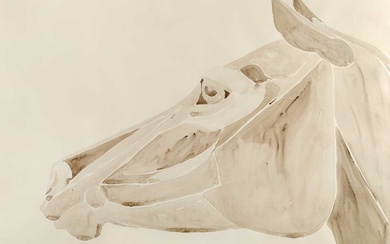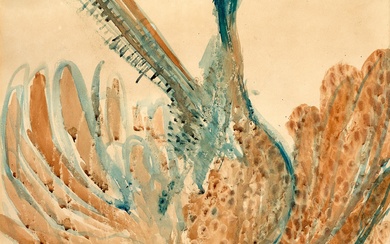DAME ELISABETH FRINK, R.A. (BRITISH, 1930-1993)
DAME ELISABETH FRINK, R.A. (BRITISH, 1930-1993)
Horse and Rider
signed and dated 'Frink 79' (lower left)
watercolour and pencil
96 x 66 cm. (37 3/4 x 26 in.)
Provenance
With Bohun Gallery, Henley-on-Thames, where purchased by the family of the present owner
Private Collection, U.K.
ARR
Dame Elisabeth Frink was born and grew up in rural Suffolk, and was intensely influenced by the effects of war. As a young child, hearing some bomber planes returning to a nearby airfield, she was forced to dive into a nearby bush and take cover to avoid the incoming fire of German fighter plane.
Frink studied under Willi Soukop at Guildford School of Art before moving to Chelsea School of Art in 1949. After this she became a key competent of the influential Geometry of Fear group which included important post-war artists Bernard Meadows, Reg Butler, Kenneth Armitage, Robert Adams, Lynn Chadwick, Geoffrey Clarke, William Turnbull and Eduardo Paolozzi.
Her work had many influences, but the conflict, masculinity and the human and animal form, were as strong as any. Another important motif and subject she would revisit on many occasions was the horse and often in interaction with the rider. Despite her initial exposure and love of horses from a young age, she would refrain from using them in much of her earlier artwork after a couple of bad accidents at the age of 16. It would only until her visit to the wilderness of Camargue in France, in the 1967, renown for its ancient indigenous breed of wild horses, that her love for the animal and subject was reignited.
The present work ‘Horse and Rider’ (1979), was painted the same year as Frink’s world record for a work on paper, ‘Horse and Rider’ (lot 67 on 30th May 2012 at Bonhams) was sold for £39,650. The painting is a love-letter to the male and the equestrian form, with both figures appearing as towers of strength, standing tall exuding power but also serenity. Unusually, it is the horse that breaks the fourth wall and holds our gaze, intensely, whilst continuing the ancient and everlasting relationship between man and beast.
“A symbol of a man on a horse, a man riding free and a horse free…intended to be completely ageless. He could come from the past or go into the future. I like to feel that work to’s and fro’s from past to present.” Elisabeth Frink, in Brian Connell ‘Capturing the Human Spirit in Big, Bronze Men’, The Times, 5 Sept 1997
View it on
Sale price
Estimate
Time, Location
Auction House
DAME ELISABETH FRINK, R.A. (BRITISH, 1930-1993)
Horse and Rider
signed and dated 'Frink 79' (lower left)
watercolour and pencil
96 x 66 cm. (37 3/4 x 26 in.)
Provenance
With Bohun Gallery, Henley-on-Thames, where purchased by the family of the present owner
Private Collection, U.K.
ARR
Dame Elisabeth Frink was born and grew up in rural Suffolk, and was intensely influenced by the effects of war. As a young child, hearing some bomber planes returning to a nearby airfield, she was forced to dive into a nearby bush and take cover to avoid the incoming fire of German fighter plane.
Frink studied under Willi Soukop at Guildford School of Art before moving to Chelsea School of Art in 1949. After this she became a key competent of the influential Geometry of Fear group which included important post-war artists Bernard Meadows, Reg Butler, Kenneth Armitage, Robert Adams, Lynn Chadwick, Geoffrey Clarke, William Turnbull and Eduardo Paolozzi.
Her work had many influences, but the conflict, masculinity and the human and animal form, were as strong as any. Another important motif and subject she would revisit on many occasions was the horse and often in interaction with the rider. Despite her initial exposure and love of horses from a young age, she would refrain from using them in much of her earlier artwork after a couple of bad accidents at the age of 16. It would only until her visit to the wilderness of Camargue in France, in the 1967, renown for its ancient indigenous breed of wild horses, that her love for the animal and subject was reignited.
The present work ‘Horse and Rider’ (1979), was painted the same year as Frink’s world record for a work on paper, ‘Horse and Rider’ (lot 67 on 30th May 2012 at Bonhams) was sold for £39,650. The painting is a love-letter to the male and the equestrian form, with both figures appearing as towers of strength, standing tall exuding power but also serenity. Unusually, it is the horse that breaks the fourth wall and holds our gaze, intensely, whilst continuing the ancient and everlasting relationship between man and beast.
“A symbol of a man on a horse, a man riding free and a horse free…intended to be completely ageless. He could come from the past or go into the future. I like to feel that work to’s and fro’s from past to present.” Elisabeth Frink, in Brian Connell ‘Capturing the Human Spirit in Big, Bronze Men’, The Times, 5 Sept 1997





